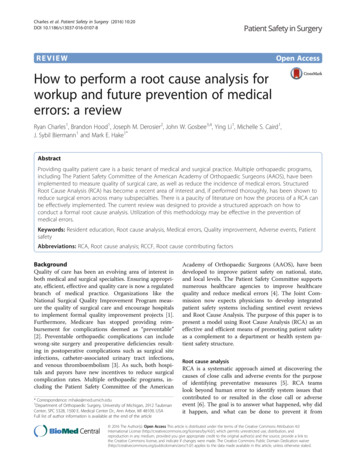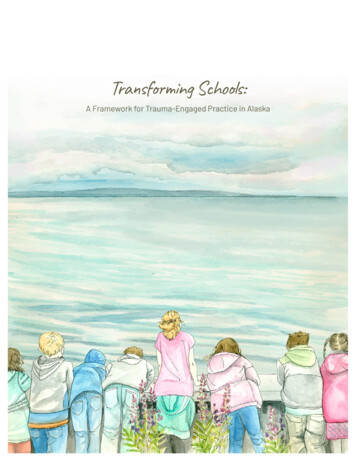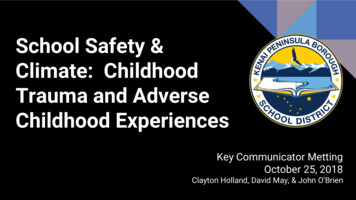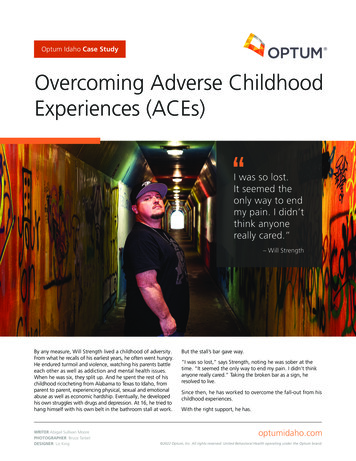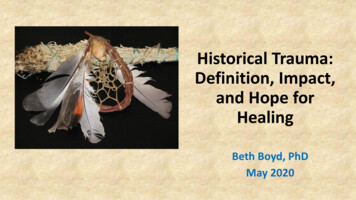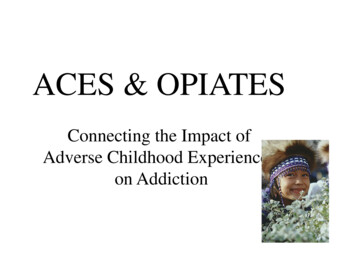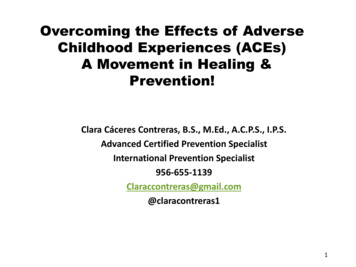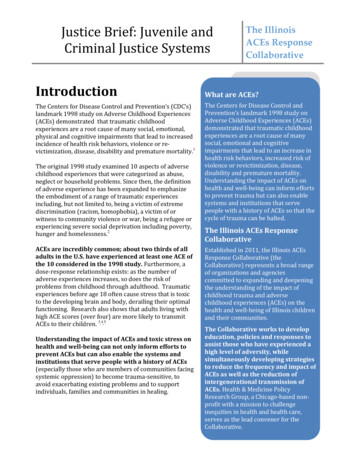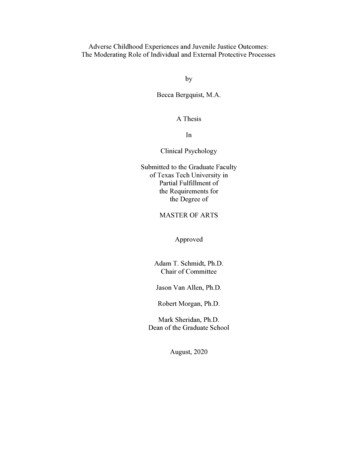
Transcription
Adverse Childhood Experiences and Juvenile Justice Outcomes:The Moderating Role of Individual and External Protective ProcessesbyBecca Bergquist, M.A.A ThesisInClinical PsychologySubmitted to the Graduate Facultyof Texas Tech University inPartial Fulfillment ofthe Requirements forthe Degree ofMASTER OF ARTSApprovedAdam T. Schmidt, Ph.D.Chair of CommitteeJason Van Allen, Ph.D.Robert Morgan, Ph.D.Mark Sheridan, Ph.D.Dean of the Graduate SchoolAugust, 2020
Copyright 2020, Becca Bergquist
Texas Tech University, Becca Bergquist, August 2020Table of ContentsAbstractivList of TablesvI. Introduction1Adverse Childhood Experiences (ACEs) and Juvenile Justice Outcomes2Protective Factors and ProcessesProtective Factors and ACEsProtective Factors and Juvenile OffendingProtective Factors and Psychopathology56811Current Study13II. Purpose16Research Questions and Hypotheses16III. Methods22Power Analysis22Participants22MeasuresThe Positive Achievement Change Tool (PACT)The Massachusetts Youth Screening Instrument232326Statistical AnalysesHypothesis 1a & 1bHypothesis 2a & 2bHypothesis 3a & 3bHypothesis 4a & 4b2727282930Data Analytic Plan and ManagementMissing DataLinearity, Homoscedasticity, and NormalityMulticollinearityOutliers3031313232IV. Results41Correlation Analyses41Regression Analyses42Supplemental Analyses46V. Discussion55Limitations64Future Directions66ii
Texas Tech University, Becca Bergquist, August 2020Clinical and Policy Implications67References70Appendices81iii
Texas Tech University, Becca Bergquist, August 2020AbstractJustice-involved youth experience significantly higher rates of adversechildhood experiences (ACEs), such as childhood maltreatment and householddysfunctions, compared to the general population. These experiences lead to ahost of negative outcomes, including greater criminal involvement and thedevelopment of mental health disorders. Literature has emphasized the need toexamine the role of protective factors, or individual traits and experiences thatbuffer the effects of adversity, on the development of these negative outcomes.This study conceptualized protective factors into two processes, specifically traitsresulting from individual processes (i.e., the person’s self-systems) and fromexternal processes (i.e., the person’s external environment) and sought tounderstand the predictive and moderating role of these processes on the relationsbetween ACEs and the negative outcomes of interest. It was found that ACEssignificantly predicted the likelihood for criminal involvement and developmentof mental health symptoms for justice-involved youth. Additionally, individualprotective processes were predictive of less criminal involvement. Neither of theprotective processes moderated the effects of ACEs on either negative outcome.Supplemental analyses provided further information concerning the findings forexternal protective processes, indicating significant associations and moderationseffects for the external protective traits. Limitations, future directions, andimplications of these findings are discussed.iv
Texas Tech University, Becca Bergquist, August 2020List of Tables1Demographic Variables332PACT Criminal History Items343Individual Protective Variables for ARQ and PACT Domains354External Protective Variables for ARQ and PACT Domains365Coding Individual Protective Process Items from PACT376Coding External Protective Process Items from PACT387MAYSI-2 Subscales and Sum Scores308Means, Standard Deviations, and Ranges for Scales409Intercorrelations of Variables4910 Hierarchical Regression Analyses of the Moderating Role of IndividualProtective Processes and External Protective Processes in the RelationBetween ACEs and Criminal History Scores5011 Hierarchical Regression Analyses of the Moderating Role of IndividualProtective Processes and External Protective Processes in the RelationBetween ACEs and Mental Health Symptoms5112 Regression Based Tests of External Protective Traits on ACEs andNegative Outcomes52v
Texas Tech University, Becca Bergquist, August 2020Chapter IIntroductionLiterature has established a relationship between adverse childhood experiences(ACEs), such as childhood maltreatment and household dysfunctions, with a multitude ofnegative life outcomes (Felitti et al., 1998). These include events such as poorer health,greater risk for alcohol and drug abuse, and increased chance of suicide (Fellitti et al.,1998). Of growing interest is the impact ACEs have on juvenile offenders, and the relatednegative outcomes that may be uniquely experienced by this population. It has beenfound that a greater prevalence of ACEs is associated with a higher risk for the presenceof mental health disorders, and effects offending trajectories in juvenile populations(Baglivio, et al., 2014; Baglivio, et al., 2015; Fox, et al., 2015). These relationships areinfluenced by the development of adolescents and their environmental experiences,which emphasizes the need to understand how protective processes such as individualcharacteristics, family dynamics, and the community influence the relationship betweenACEs and outcomes faced by justice-involved youth. Understanding what theseprocesses are, and how they impact ACEs, mental health, and risk for juvenile offending,may aid in a more cohesive comprehension of the protective factors that may beenhanced to help decrease negative life outcomes. This type of research could be used toguide the development and utilization of strategies to treat youth with mental healthproblems, as well as better comprehend what impacts a juvenile’s likelihood ofdelinquency, most specifically when these needs are associated with the accumulation oftraumatic experiences from childhood (Desai et al., 2006; Logan-Green et al., 2017).1
Texas Tech University, Becca Bergquist, August 2020The proposed study seeks to examine the moderating effect of protectiveprocesses on the relationship between ACEs and mental health, and ACEs and juveniledelinquency within a juvenile sample. Specifically, how individual protective processesand external protective processes may buffer the effect of ACEs on the development ofthese negative outcomes faced by justice-involved youth.Adverse Childhood Experiences (ACEs) and Juvenile Justice OutcomesAdverse Childhood Experiences (ACEs) refer to trauma related experiences suchas childhood maltreatment and household dysfunctions. These have been categorized bythe Centers for Disease Control and Prevention (CDC) into 10 specific childhoodexperiences: emotional abuse, physical abuse, sexual abuse, emotional neglect, physicalneglect, violent treatment towards mother, household substance abuse, household mentalillness, parental separation or divorce, and having an incarcerated household member(Baglivio et al., 2014; CDC, 2015; Felitti et al., 1998). This conceptualization hasemphasized the cumulative nature of these traumatic experiences, which allows for abroader understanding of how these events impact future negative outcomes. The ACEscore is the sum of these 10 experiences, each measured dichotomously, such that oneadverse experience is counted as one point (Felitti et al., 1998; Wolff et al., 2015). Theidentification of these experiences has exposed a variety of negative correlates, such ashealth-related ailments (Bellis, et al., 2014; Felitti et al., 1998; Fox et al., 2015;), higherrisk for poor education and employment outcomes (Bellis et al., 2014), and higher riskfor the presence of psychopathology (Anda, et al., 2010; Bellis et al., 2014; Fox et al.,2015).2
Texas Tech University, Becca Bergquist, August 2020In the context of justice-involved youth, the prevalence rate of adversitycompared to the general population is much higher, with an average of three ACEs ormore (Abram et al., 2004; Baglivio et al., 2014; Dierkhising et al., 2013). For thesejuveniles, the accumulation of multiple ACEs has been associated with a greaterlikelihood of earlier age of first arrest (Baglivio et al., 2015), increased risk of criminalbehavior (Fox et al., 2015), and increased likelihood of a shorter time between re-arrests(Wolff et al., 2015). In a sample of sexually violent juvenile offenders, those with agreater accumulation of developmental and environmental risk factors, such asparticipation in criminal activity at a young age, heightened impulsivity, and multipleincidents of ACEs, were 35% more likely to become “serious, violent, and chronicjuvenile offenders” while controlling for other common risk factors of criminal behavior(Fox et al., 2015).Baglivio and colleagues (2015) examined the relationship between ACEs andjuvenile offending patterns, where they specifically examined ACEs and offendingtrajectories while controlling for relevant criminal risk factors (e.g., aggressive behavior,impulsivity, familial risk factors, school behavior, etc.). They found that a greater numberof ACEs significantly predicted chronic offending behavior, and those with six or moreACEs were more predictive of being in the “early-starter” category of offendingtrajectories. Wolff and colleagues (2015) found that a higher presence of ACEs in ajuvenile population shortened the time between the number of days between completionof their sentence and re-arrest. This held true after controlling for demographics, andindividual and personal history risk factors (i.e., age at first offense, prior felony, schoolbehavior). These studies demonstrate that ACEs, importantly the accumulation of3
Texas Tech University, Becca Bergquist, August 2020multiple adverse experiences, have a significant impact on a juvenile’s risk of developingfurther offending behaviors.Additionally, justice-involved youth are more likely to experience mental healthproblems compared to adolescents in the general population (Fazel et al., 2008; Hoeve etal., 2015). While examining the prevalence of mental health disorders among theNorthwestern Juvenile Project, which consists of 1,829 youth in detention within a 3-yearperiod (1995-1998), it was found that even after controlling for conduct disorder, acommon disorder within this population, approximately 60% of males and two-thirds offemales met diagnostic criteria for one or more mental disorders (Teplin et al., 2002).Within this same sample, Teplin and colleagues (2012) followed up with participants todetermine the persistence and prevalence of mental health disorders five years after theirtime in detention. Adolescents aged 14 to 24 were among those who had persistent ratesof mental health disorders, with half of males and 30% of females having one or moremental disorders. The high prevalence and persistence of mental health disorders may beinfluenced by a youth’s high exposure to ACEs (Hoeve et al., 2015).Kerig and colleagues (2009) found that trauma exposure within justice-involvedyouth was positively associated with posttraumatic stress disorder (PTSD), which wassubsequently related to other mental health problems (i.e., anxiety, depression, conductrelated problems, and substance use). Hoeve and colleagues (2015) examined theassociations between childhood trauma and mental health problems in justice-involvedmales, and how these associations would differ between childhood-onset and adolescentonset offenders. Childhood maltreatment significantly predicted mental health problemswithin both offender types, with a stronger relationship in the adolescent-onset offender4
Texas Tech University, Becca Bergquist, August 2020group (childhood trauma and covariates explained 45% of the variance, compared to 20%in the childhood-onset group). Additionally, Vahl and colleagues (2016) found thatwithin detained adolescents, emotional abuse was uniquely associated with internalizingand externalizing mental health problems, specifically over and above the effects of othertypes of maltreatment.This extant research helps demonstrate that ACEs pose a number of challenges tothe healthy development of justice-involved youth. While the identification of theseexperiences is beneficial for understanding the outcomes resulting from ACE exposure,this information does not help determine the areas of intervention that may assist intargeting these negative outcomes. Thus, there is a critical need to understand themechanisms that buffer youth from greater risk of delinquency and developing symptomsof psychopathology resulting from ACE exposure.Protective Factors and ProcessesProtective factors are those that moderate risk and adversity and enhancedevelopmentally appropriate outcomes (Werner, 2000). They include the identification ofcharacteristics and traits that assist in overcoming adversity, thereby modifying,alleviating, or changing an individual’s response to these experiences (Resnick, 2000;Rutter, 1985). These traits are those that may have come from experiences or processesthat have developed over time, particularly during the adolescent period. From adevelopmental perspective, these factors are those that originate from external processes(e.g., extra-familial environments such as peers, community, and school, and familialenvironments). Additionally, individual processes (e.g., self-system processes such asself-confidence, social skills, self-beliefs, cognitions) are those that originate within the5
Texas Tech University, Becca Bergquist, August 2020individual (Chase-Landsale et al., 1995; Resnick, 2000). These individual processes andexternal processes involve the development of the psychological, social, and physicalresources that are needed to successfully progress in the context of adverse experiences(Ungar et al., 2013) and decrease the likelihood of negative outcomes (Betancourt &Khan, 2008). These protective variables interact with multiple areas that play animportant role in the context of individual development, comparable toBronfrenbrenner’s bio-psycho-social model of human development (Bronfrenbrenner,1979; Ungar et al., 2013).In the context of justice-involved youth, these developmentally-based protectivefactors are useful in reducing risky behaviors that lead to delinquency. For example,Benson and colleagues (2006) have found that the more protective assets youth possess,such as family support, positive adult role models, and positive self-values likeresponsibility and integrity, the less likely they are to be involved in violent behavior andsubstance use. Additionally, protective factors have been found to assist justice-involvedyouth’s trajectory into adulthood by allowing them to avoid criminality and be moresuccessful within their community (Todis et al., 2001; Unruh, Povenmire-Kirk, &Yamamoto, 2009). Thus, based on the current literature, the effects between adverseexperiences, juvenile delinquency, and mental health may interact with protective factorsresulting from individual processes and/or external processes for justice-involved youth.Protective Factors and ACEs.Within the context of ACEs, there is literature to support the presence of specificfactors resulting from protective processes that buffer the effect of these adverseexperiences over time. These include an individual’s personal characteristics, attachment6
Texas Tech University, Becca Bergquist, August 2020to a caregiver, close personal relationships with others, and having a protective community(Masten et al., 2009; Sciaraffa et al., 2017). Among individual characteristics, some of themost important factors are effective problem-solving skills, self-regulation, andadaptability to stress. For family-related factors, secure attachments and positive familyenvironments are found to be the most important. Within the community, the most salientfactors are effective schools, ties to prosocial organizations, and high collective efficacywithin the individual’s neighborhood (Masten et al., 2009). Thus, adverse experiences canbe buffered through protective factors that result from individual processes, such as selfregulation and coping skills, or external processes, such as the family unit, peer association,school involvement, and positive communities.For example, Brady and colleagues (2008) helped demonstrate that adaptivecoping, a protective factor resulting from individual processes, can help safeguard againstthe harmful effects of being exposed to adverse experiences. They examined theassociation between community violence exposure and later violent behavior, and thebuffering effect of a youth’s engagement in adaptive coping strategies. Coping wasdefined as the effectiveness of the youth to respond to or deal with violent events over 4time waves, which was coded into seven levels of coping responses (i.e., learning newskills, proactively confronting others, seeking advice, accepting the situation, etc.) basedon the pattern of their responding. It was found that greater community violence wasassociated with later violent behavior for youth whose coping strategies were poor, butnot for those who coped well. Those who had adaptive coping strategies over a long-termperiod used strategies such as seeking advice from others, focusing on the positiveaspects of their lives, and engaging in activities that enhanced their self-esteem. Those7
Texas Tech University, Becca Bergquist, August 2020who did not have adaptive coping strategies were more likely to use substances, arguewith others, isolate themselves from others, and reported enjoying watching others beingbeat up.Protective Factors and Juvenile Offending.The assessment and identification of protective factors for juvenile offenders canbe found within frequently used risk assessment measures. For example, the StructuredAssessment of Violence Risk in Youth (SAVRY; Borum et al., 2005) is a valid andreliable adolescent risk assessment that has three risk domains and a protective domain,which contains six items (Pro-social involvement, strong social support, strongattachments and bonds, positive attitude toward intervention and authority, strongcommitment to school, and resilient personality traits) and are measured dichotomouslyto result in a total protective factor score. The Youth Level of Service/Case ManagementInventory YLS/CMI; Hoge & Andrews, 2011) is a commonly used risk/needs instrumentthat includes a “strength” box that can be checked by the rater for each subscale of themeasure. These strengths include: education/employment, peer relations, familycircumstances, attitudes/orientations, leisure recreation, substance use, andpersonality/behavior. Thus, while there are various conceptualizations for how to applyprotective factors to juvenile offenders, there is research to support the inclusion andvalidity of these items in this population for various adverse outcomes.Other literature demonstrates how protective factors impact a juvenile’s risk level,which is used to help predict their likelihood to participate in future criminal behavior.Shepherd and colleagues (2016) sought to study if the presence of protective factors in ajustice-involved sample would differ across offenders’ risk level, and if they would affect8
Texas Tech University, Becca Bergquist, August 2020their time to reoffend across these risk levels. They utilized the protective domain of theSAVRY to demonstrate that high risk was associated with a lower presence of protectivefactors. Additionally, offenders with three or more protective factors were found to takelonger to reoffend, compared to those with no protective factors who reoffended muchearlier. Interestingly, the presence of multiple protective factors was associated with asignificantly reduced time to recidivism for low-risk offenders, but was not associated forhigh-risk offenders. Thus, within this sample, high-risk offenders were not affected bythe presence of a greater number of protective factors. These results contrast with thoseby Lodewijks and colleagues (2010), which found that a greater number of protectivefactors buffered the effect of recidivism in the high-risk and low-risk offender groups.Shepherd and colleagues (2018) conducted a second study examining the impact of“strength” items within the YLS/CMI. Youth with no strength items were more likely tobe categorized as either high risk or very high risk, with no youth in the very high riskcategory possessing any strength items. All youth categorized as low risk had at least onestrength item. Additionally, if a youth had at least one strength item they were 3.2 timesless likely to reoffend than a youth with no strengths. Finally, they found that having anyamount of strength items had a negative relationship with reoffending after controllingfor risk level, which contrasted their findings from their original study in 2016 (Shepherdet al., 2016).A few studies specifically examine the moderating role of protective factors onthe relationship between adverse experiences and juvenile offending. Chen andcolleagues (2016) examined the effect of promotive factors on the relationship betweencommunity violence exposure and adolescent delinquency. The promotive factors were9
Texas Tech University, Becca Bergquist, August 2020measured within four domains: individual (i.e., future expectations), family (i.e., familywarmth), school (i.e., school attachment), and community (i.e., neighborhood cohesion)All promotive factors were associated with lower levels of delinquency, with strongereffects for family warmth and school attachment than future expectations and communitycohesion. In addition, it was found that future expectations were the only domain ofpromotive factors to moderate the relationship between community violence exposureand adolescent delinquency when examining all promotive domains simultaneously.Specifically, they found lower levels of adolescent delinquency for those who had higherlevels of future expectations compared to lower levels. This research demonstrated thatindividual protective processes had more of a moderating effect between adverseexperiences and delinquency, compared to external-based protective processes. Whilethis research used a different operationalization for these buffering factors, the domainsare aligned with the previously mentioned research by Masten et al. (2009) thatemphasizes the importance of different domains of protective variables, such asindividual and external protective processes.Consistent with the findings of Chen and Colleagues (2016), So and colleagues(2018) examined the moderating effects of future orientation, a protective individualcharacteristic, on community violence exposure and delinquent behavior among AfricanAmerican adolescents. Delinquent behavior was measured as the participation in illegal,norm-violating, and aggressive behaviors over a 12-month period. It was found thatfuture orientation was a significant moderator of community violence exposure withdelinquent behavior, such that high levels of exposure was more predictive of higherlevels of delinquent behavior, with a stronger effect when future orientation levels were10
Texas Tech University, Becca Bergquist, August 2020low. Additionally, Craig and colleagues (2017) investigated the effects of social bonds, aprotective factor resulting from external protective processes, on the relationship betweenACEs and reoffending in a sample of justice-involved youth. Social bonds were definedas a form of attachment to others, having prosocial community ties, having prosocialfriends, and feeling close to a prosocial parent or caretaker. Having a higher ACE scoresignificantly increased the chance of re-arrest for those with both strong and weak socialbonds. They found that among youth with zero to five ACEs, those with stronger socialbonds were less likely to be rearrested compared to those with weaker bonds. But onceyouth reached six or more ACEs, this relationship was no longer present, indicating thatthe effect of social bonds in the context of ACE exposure reaches a threshold forprotective effects. Thus, among these studies, it is found that individual protectiveprocesses have moderating effects between adverse experiences and aspects of juveniledelinquency, but evidence is not as strong for the protective effects of external protectiveprocesses.Protective Factors and Psychopathology.Mental health disorders among adolescents may be buffered by the effect ofprotective factors resulting from individual and external protective processes. In a sampleof adolescents studied over the course of three years, Olives and colleagues (2013) foundthat self-reported mental health problems were positively affected by external protectiveprocesses, specifically the influence of a healthy home environment (i.e., familycohesion, parents’ availability, and perception of support by family). Brown et al. (1999)found differential effects for individual and external protective processes within a sampleof juvenile offenders who met diagnostic criteria for any mental health disorder. Those11
Texas Tech University, Becca Bergquist, August 2020who had higher family cohesion, developed through external protective processes, wereless likely to have comorbid mental health disorders. Additionally, those with higheremotional bonding with peers, developed through individual protective processes, wereless likely to have internalizing mental health disorders. Furthermore, youth who havehigh levels of self-compassion (Muris, 2016), optimism, and self-esteem (Dooley et al.,2015; Kassis et al., 2017), which are encompassed among individual protectiveprocesses, have been found to have lower levels of psychopathology.Additionally, there is research to support the moderating role that protectivefactors have on the relationship between adverse experiences and the development ofpsychopathology among justice-involved youth. Rosenberg and colleagues (2014)examined the relationship between trauma, mental health, and resiliency factors in apopulation of justice-involved youth. They utilized the Youth Resiliency Checklist that isdivided into six subscales that test for protective factors (i.e., social skills, involvement,family strengths, school strengths, social supports, and positive outlook). It was foundthat while a total score of resiliency did not moderate the effect of trauma on depressionor PTSD, the subscale Involvement (which assesses for protective factors such asvolunteer work, belonging in a community group, and employment), similar to externalprotective processes, moderated the relationship between trauma and depression, suchthat higher involvement lessened the effect of trauma on depressive symptoms.Another study examined 116 male juvenile offenders to determine if therelationship between community violence exposure and psychological distress ismoderated by caregiver adult support and caregiver control (Ball et al., 2007).Psychological distress was measured using the Massachusetts Youth Screening12
Texas Tech University, Becca Bergquist, August 2020Instrument (MAYSI; Grisso & Barnum, 1998), and psychological distress wasdichotomized into internalizing symptoms (depressed-anxious subscale) andexternalizing symptoms (alcohol/drug use scale). They found that the relationshipbetween community violence exposure and alcohol/drug use, and between communityviolence exposure and depression/anxiety, was significant when caregiver adult supportwas low, but not when support was high. Additionally, Logan-Green and colleagues(2017) found that coping resources, specifically social support, was a moderator betweenchildhood maltreatment and suicidal ideation, such that having low social support andhigh childhood maltreatment made suicidal ideation more likely. Thus, Ball et al. (2007)and Logan-Green et al. (2017) help demonstrate that external protective processes havemoderating effects between adverse experiences and the development ofpsychopathology among justice-involved youth.Current StudyThe current literature discussed has demonstrated that ACEs are related to a hostof negative outcomes, particularly among justice-involved youth. The negative outcomesof interest in this study, specifically enhanced risk of delinquent behavior anddevelopment of psychopathology, may be moderated by protective factors that resultfrom individual and external processes. Similar to Bronfrenbrenner’s bio-psycho-socialmodel, protective traits may result from multiple areas such as within the individual andthrough microsystems, or external processes, such as the family, the community, etc.Based on the theoretical conceptualizations of protective factors for adolescents,emphasis has been placed on domains such as individual, family, and communityprocesses (Chase-Lansdale et al., 1995; Masten et al., 2009; Ungar et al., 2013). Research13
Texas Tech University, Becca Bergquist, August 2020has stressed that the development of protective factors includes positive development ofindividual characteristics, such as emotion regulation, as well as external processes, suchas family dynamics (Masten et al., 2009). Many studies have examined and emphasizedthe need for understanding the role of protective factors in the development of emotional,behavioral, and social outcomes in youth in the juvenile justice system who haveextremely high rates of exposure to adversity (Brown et al., 1999; Fitzpatrick, 1997;Hamby, et al., 2018; Masten et al., 2009). Yet, most research has examined the effects ofindividual protective traits/characteristics, or protective factors resulting from externalprocesses independently, without examining how these two areas may interact or differacross negative outcomes. However, it is important to understand how these differentlevels of protective factors operate in order to design more efficient, targeted interventionprograms that can reduce negative outcomes across domains. (Dekovic, 1999; Masten etal., 2009).Additionally, the available research inconsistently examines adverse experiences,with some research utilizing a total ACE score, and others examining individual facets ofACEs. The previou
Adverse Childhood Experiences (ACEs) refer to trauma related experiences such as childhood maltreatment and household dysfunctions. These have been categorized by the Centers for Disease Control and Prevention (CDC) into 10 specific childhood experiences: emotional abuse, physical abuse, sexual abuse, emotional neglect, physical

